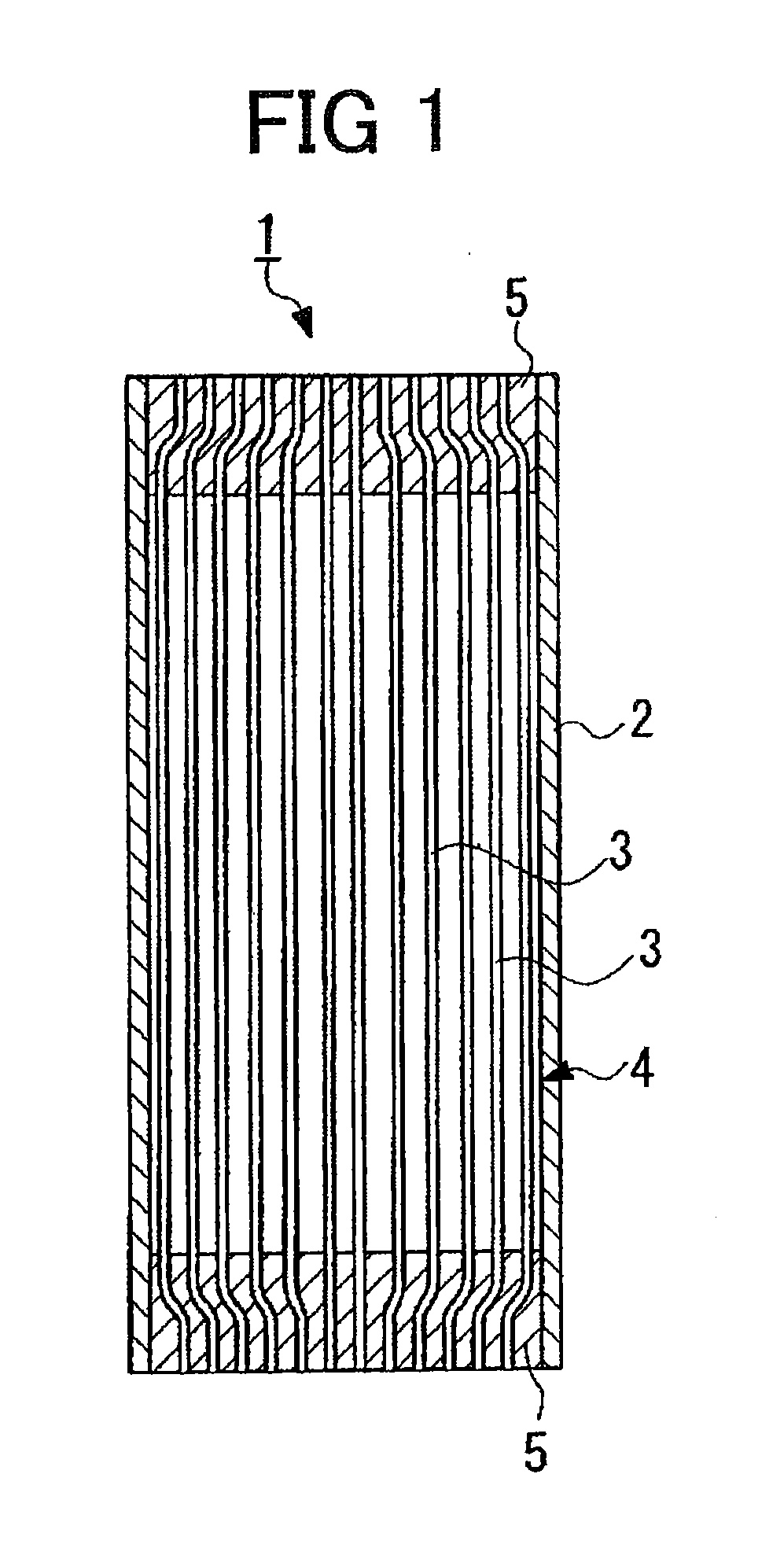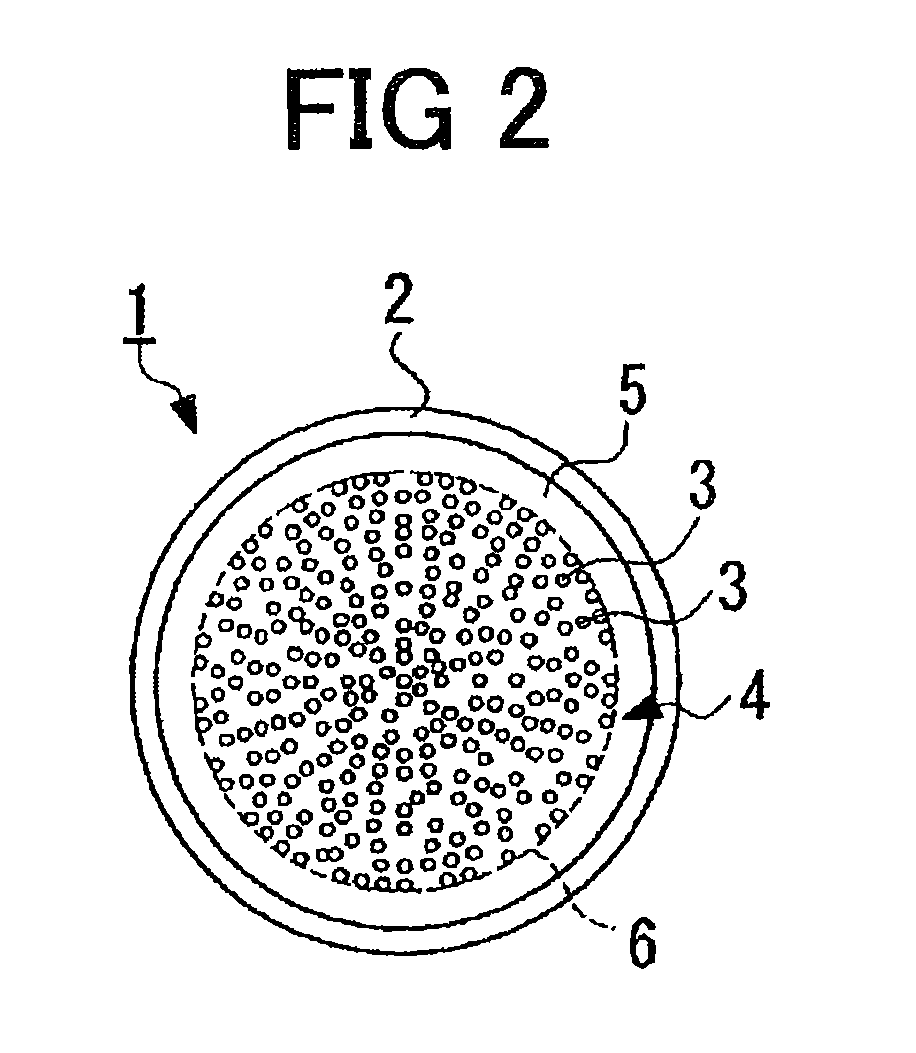Polyolefin-composite hollow-fiber membrane and manufacturing method for same, and hollow-fiber membrane module
- Summary
- Abstract
- Description
- Claims
- Application Information
AI Technical Summary
Benefits of technology
Problems solved by technology
Method used
Image
Examples
examples
[0114]Below, the present invention is explained in detail by way of Examples and Comparative Examples. However, the present invention is not limited in any way, by the disclosures below.
(Melt Flow Rate (MFR))
[0115]In regard to MFR of polyolefin, MFRD (unit: g / 10 min.) was measured in accordance with code D of JIS K7210 (measurement temperature: 190° C., load: 2.16 kg), and MFRG (unit: g / 10 min.) was measured in accordance with code G of JIS K7210 (measurement temperature: 190° C., load: 21.6 kg).
[0116]Furthermore, from these results, FRR(G / D)(=MFRG / MFRD) was calculated.
(Density)
[0117]Density of polyolefins (unit: kg / m3) was measured in accordance with JIS K7112.
(Mw / Mn Ratio)
[0118]The Mw / Mn ratio of polyolefins was calculated from Mw and Mn derived from the calibration curve obtained by measurements of GPC (high temperature GPC) made under the condition described below. For the calibration curve, polystyrene standards were measured and the calibration curve was plotted using polyethy...
examples 1
[0145]As polyolefin A (for the formation of the homogeneous membrane layer), ethylene-octene copolymer produced using metallocene catalyst (commercially available with product name “Affinity EG8100G”, Dow Chemical Co., MFRD: 1.0 g / 10 min., density: 0.870 g / cm3, melting point Tm: 55° C., Mw / Mn=2.0, octene content: 35 mol %) was used.
[0146]As polyolefin B (for the formation of the porous membrane layer), high density polyethylene produced using Ziegler catalyst and three step continuous polymerization method (product name “H6670B”, SCG Chemical Co., density: 0.966 g / cm3, MFRD: 0.7 g / 10 min., MFRG: 54 g / 10 min., FRR(G / D)=77, FL: 0.38 mass %, FH: 2.64 mass %, Mw / Mn=8.8, ESCR: 20 hours) was used. The three components approximated by Gaussian distribution from the molecular weight distribution chart obtained by high temperature GPC of the high density polyethylene used for the formation of the porous membrane layer was as follows.
[0147]The chart exhibited two shoulder peaks, one at around...
examples 2
[0150]As polyolefin A, ethylene-octene copolymer produced using metallocene catalyst (commercially available with product name “ENGAGE 7387”, Dow Chemical Co., MFRD: 0.5 g / 10 min., density: 0.870 g / cm3, melting point Tm: 50° C., Mw / Mn=2.0, octene content: 35 mol %) was used.
[0151]As polyolefin B, high density polyethylene produced using Ziegler catalyst and three step continuous polymerization method (product name “H6430BM”, SCG Chemical Co., density: 0.966 g / cm3, MFRD: 0.4 g / 10 min., MFRG: 30 g / 10 min., FRR(G / D)=75, FL: 0.66 mass %, FH: 3.07 mass %, Mw / Mn=12, ESCR: 24 hours) was used.
[0152]The three components approximated by Gaussian distribution from the molecular weight distribution chart obtained by high temperature GPC of the high density polyethylene used for the formation of the porous membrane layer was as follows. The chart exhibited two shoulder peaks, one at around molecular weight of 1 million, and another at around molecular weight of 5000.
1) Mn: 2.81×103 Mw: 6.57×103 ...
PUM
| Property | Measurement | Unit |
|---|---|---|
| Percent by mass | aaaaa | aaaaa |
| Percent by mass | aaaaa | aaaaa |
| Density | aaaaa | aaaaa |
Abstract
Description
Claims
Application Information
 Login to View More
Login to View More - R&D
- Intellectual Property
- Life Sciences
- Materials
- Tech Scout
- Unparalleled Data Quality
- Higher Quality Content
- 60% Fewer Hallucinations
Browse by: Latest US Patents, China's latest patents, Technical Efficacy Thesaurus, Application Domain, Technology Topic, Popular Technical Reports.
© 2025 PatSnap. All rights reserved.Legal|Privacy policy|Modern Slavery Act Transparency Statement|Sitemap|About US| Contact US: help@patsnap.com



